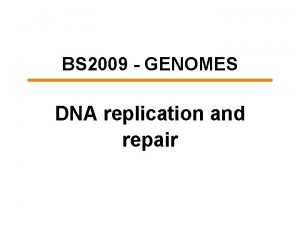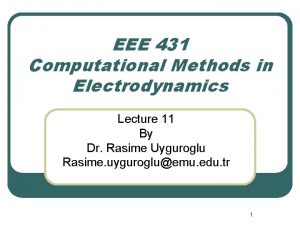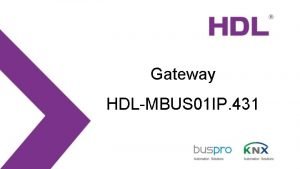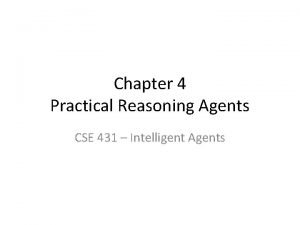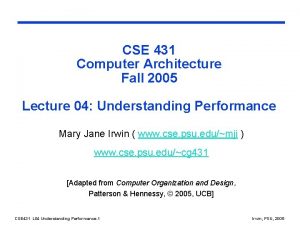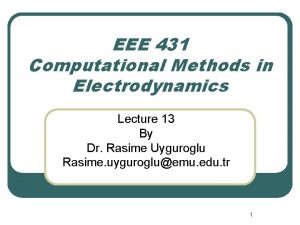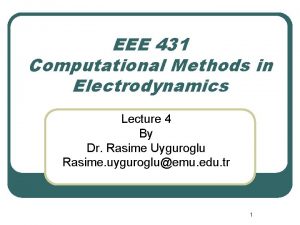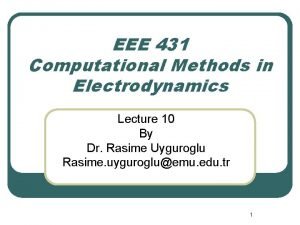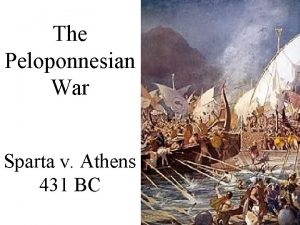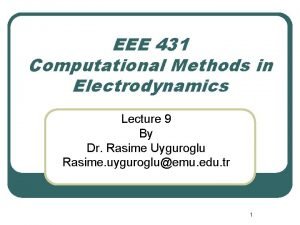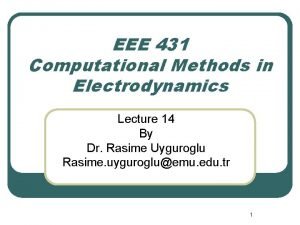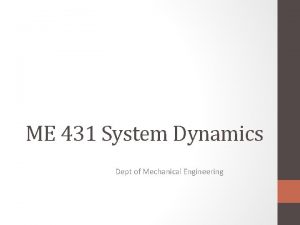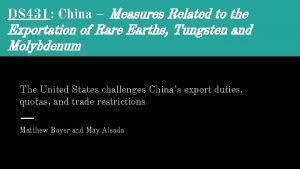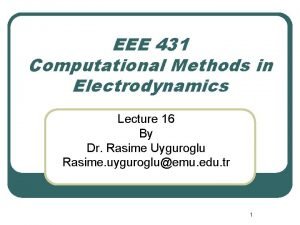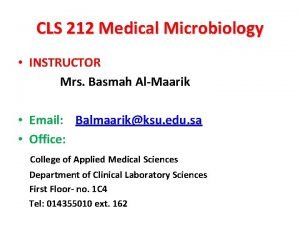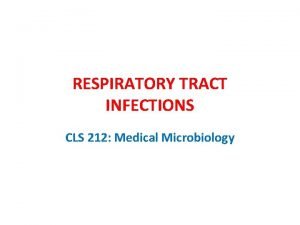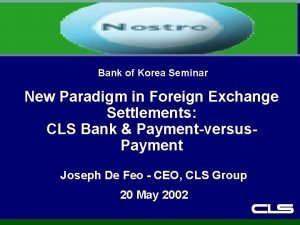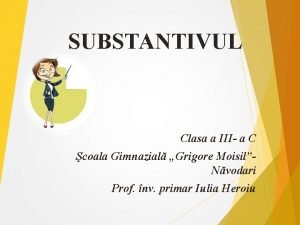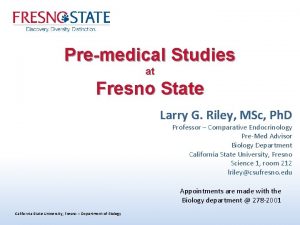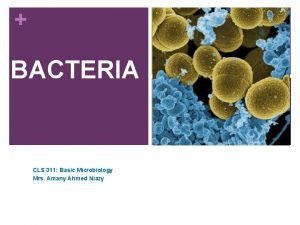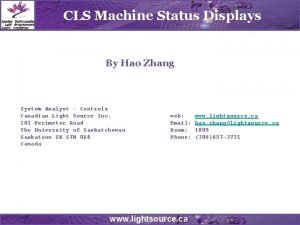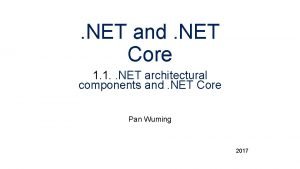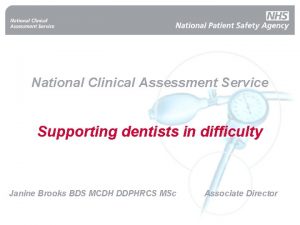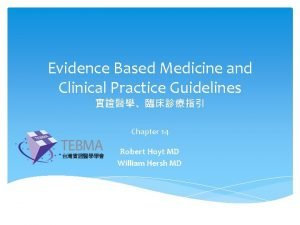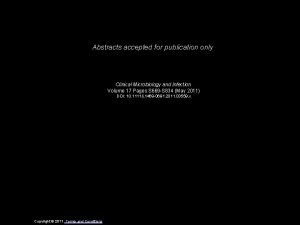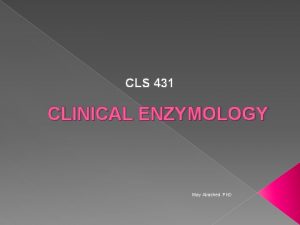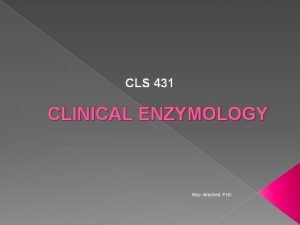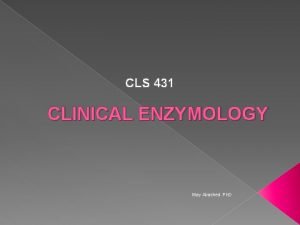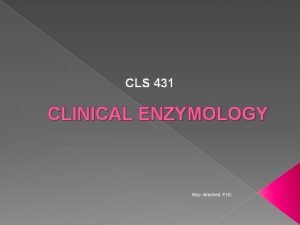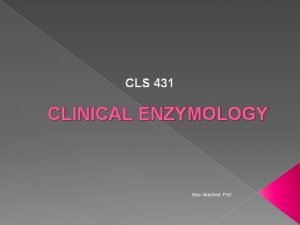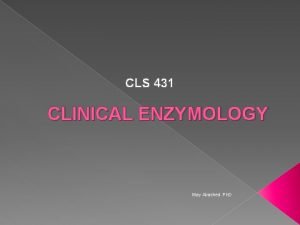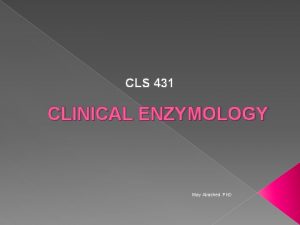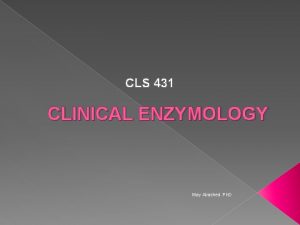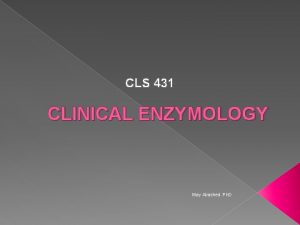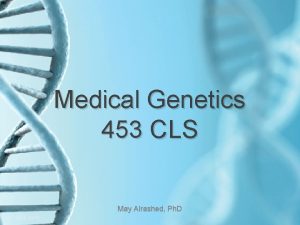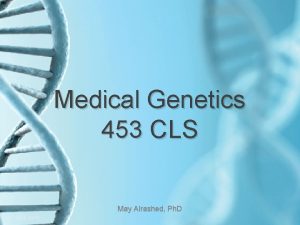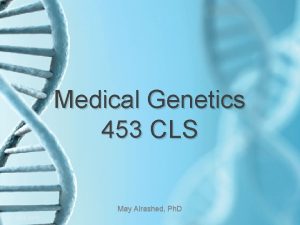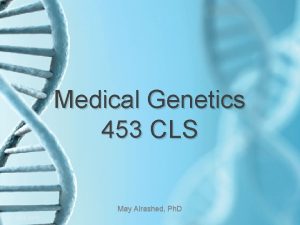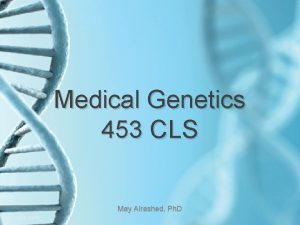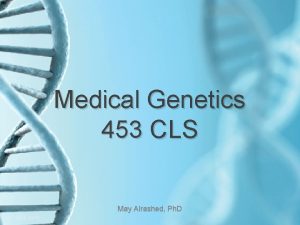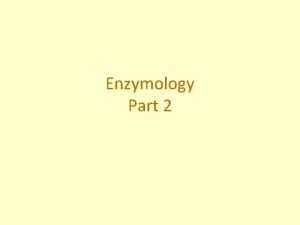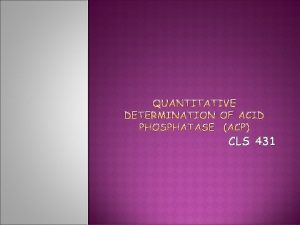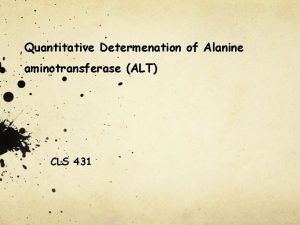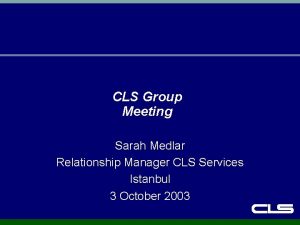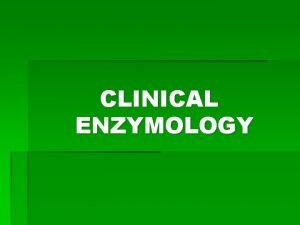CLS 431 CLINICAL ENZYMOLOGY May Alrashed Ph D





































![Enzyme Kinetics: Michaelis-Menton Equation Vmax[S] Vo = ______ KM + [S] KM = [S] Enzyme Kinetics: Michaelis-Menton Equation Vmax[S] Vo = ______ KM + [S] KM = [S]](https://slidetodoc.com/presentation_image/809011e40a55550f52d2a8a3d74ed92f/image-38.jpg)



- Slides: 41

CLS 431 CLINICAL ENZYMOLOGY May Alrashed. Ph. D

General properties Ø Enzymes are protein catalyst that increase the velocity of a chemical reaction. Ø Enzymes are not consumed during the reaction they catalyzed. Ø With the exception of catalytic RNA molecules, or ribozymes, enzymes are proteins. Ø In addition to being highly efficient, enzymes are also extremely selective catalysts. May Alrashed. Ph. D

Coenzymes and Cofactors Ø Cofactors can be subdivided into two groups: metals and small organic molecules. Ø Cofactors that are small organic molecules are called coenzymes. Ø Most common cofactor are also metal ions. Ø If tightly bound, the cofactors are called prosthetic groups. Ø Loosely bound Cofactors serve functions similar to those of prosthetic groups but bind in a transient, dissociable manner either to the enzyme or to a substrate. May Alrashed. Ph. D

Coenzymes May Alrashed. Ph. D

Prosthetic group Ø Metals are the most common prosthetic groups. Ø Tightly integrated into the enzyme structure by covalent or non-covalent forces. e. g; › Pyridoxal phosphate › Flavin mononucleotide( FMN) › Flavin adenine dinucleotide(FAD) › Thiamin pyrophosphate (TPP) › Biotin › Metal ions – Co, Cu, Mg, Mn, Zn May Alrashed. Ph. D

Role of metal ions Ø Enzymes that contain tightly bound metal ions are termed – Metalloenzymes. Ø Enzymes that require metal ions as loosely bound cofactors are termed as metal-activated enzymes. Ø Metal ions facilitate Ø Binding and orientation of the substrate. Ø Formation of covalent bonds with reaction intermediates. Ø Interact with substrate to render them more electrophilic or nucleophilic. May Alrashed. Ph. D

May Alrashed. Ph. D

Active Site Ø Active site is a region in the enzyme that binds substrates and cofactors. Ø Takes the form of a cleft or pocket. Ø Takes up a relatively small part of the total volume of an enzyme. Ø Substrates are bound to enzymes by multiple weak attractions. Ø The specificity of binding depends on the precisely defined arrangement of atoms in an active site. Ø The active sites of multimeric enzymes are located at the interface between subunits and recruit residues from more than one monomer. May Alrashed. Ph. D

Active Site Two models have been proposed to explain how an enzyme binds its substrate: Ø lock-and –key model. Ø Induced-fit model. May Alrashed. Ph. D

Lock & Key Model of Enzyme. Substrate Binding In this model, the active site of the unbound enzyme is complementary in shape to the substrate. May Alrashed. Ph. D 10

Induced-Fit Model of Enzyme. Substrate Binding In this model, the enzyme changes shape on substrate binding. Ø The active site forms a shape complementary to the substrate only after the substrate has been bound. Ø May Alrashed. Ph. D

Enzyme Specificity In general, there are four distinct types of specificity: Ø Absolute specificity The enzyme will catalyze only one reaction. Ø Group specificity the enzyme will act only on molecules that have specific functional groups, such as amino, phosphate and methyl groups. Ø Linkage specificity the enzyme will act on a particular type of chemical bond regardless of the rest of the molecular structure. Ø Stereo chemical specificity the enzyme will act on a particular steric or optical isomer. May Alrashed. Ph. D

Absolute specificity Ø Is the highest degree of specificity. Ø The enzyme active site is recognized by a single substrate. Ø Example: Glucokinase catalyzes the conversion of glucose to glucose -6 -phosphate May Alrashed. Ph. D

Group specificity Ø Enzyme active site can recognize many substrates , all belonging to same group of compounds. Example: Ø Trypsin catalyzes the hydrolysis of peptide bond in several proteins. Ø Hexokinases act on six carbon sugars. Ø May Alrashed. Ph. D

Reaction specificity Ø The enzyme catalyzes only one type of reaction Example: Ø Oxidoreductases catalyze oxidation –reduction reactions Ø May Alrashed. Ph. D

Optical specificity Enzyme is stereospecific. Ø Is capable to differentiate between L- and D- isomers of a compound. Ø Example: Ø › L amino acid oxidase acts only on L-amino acid. › α-glycosidase acts only on α-glycosidic bond which are present in starch and glycogen. › β-glycosidase acts only on β -glycosidic bond that are present in cellulose. (think)*** May Alrashed. Ph. D

Mechanism of Action of Enzymes How do enzymes catalyze? The basic enzymatic reaction can be represented as follows ES complex EX complex http: //www. wiley. com/college/pratt/0471393878/instructor/animations/enzyme_kinetics/index. html May Alrashed. Ph. D

How do enzymes increase the rate of reaction? Enzymes increase reaction rates by decreasing the amount of energy required to form a complex of reactants that is competent to produce reaction products. Ø This complex is known as the activated state or transition state complex for the reaction. Ø Enzymes and other catalysts accelerate reactions by lowering the energy of the transition state. Ø May Alrashed. Ph. D

Stabilization of the Transition State The catalytic role of an enzyme is to reduce the energy barrier between substrate and transition state. Ø This is accomplished through the formation of an enzyme-substrate complex (ES). Ø This complex is converted to product by passing through a transition state (EX‡). Ø The energy of EX is lower than for X. Therefore, this decrease in energy partially explains the enzymes ability to accelerate the reaction rate. Ø May Alrashed. Ph. D

May Alrashed. Ph. D

Mechanism of Action of Enzymes Ø The combination formed by an enzyme and its substrates is called the enzyme–substrate complex. Ø When two substrates and one enzyme are involved, the complex is called a ternary complex; one substrate and one enzyme are called a binary complex. Ø The substrates are attracted to the active site by electrostatic and hydrophobic forces, which are called noncovalent bonds because they are physical attractions and not chemical bonds Ø May Alrashed. Ph. D

The mechanism of action of enzymes can be explained by two perspectives ØThermodynamic changes ØProcesses at the active site May Alrashed. Ph. D

1) Thermodynamic changes Enzymes accelerate reactions by lowering the free energy of activation Ø Enzymes do this by binding the transition state of the reaction better than the substrate Ø The lower activation energy means that more molecules have the required energy to reach the transition state. Ø May Alrashed. Ph. D

May Alrashed. Ph. D

Free energy change Ø Ø Ø ΔG# : (Standard free energy change (Gibbs free energy)→it is ΔG under standard state conditions. Standard free energy change (Gibbs free energy) It is energy difference in free energy between substrate and product. ΔG o = G product – G substrate ΔG o expresses the amount of energy capable of doing work during a reaction at constant temp. and pressure. If free energy of substrate and product is same then ΔG° is zero. The reaction is said to be at equlibrium. May Alrashed. Ph. D 25

Ø Ø Ø Ø The relationship between Keq and ΔGo : ΔG o = -RT ln Keq R : gas constant , ΔG°= -2. 303 RT log Keq T : absolute Temp (t + 273) → 298 k(c°) Keq= [P][S] Both ΔG°and Keq tell in which direction and how for a reaction will proceed when all substrates and products are 1 M May Alrashed. Ph. D

Effect of a Catalyst (enzymes) on Activation Energy May Alrashed. Ph. D

2) Processes at the active site Catalysis by proximity When an enzyme binds substrate molecules at its active site, it creates a region of high local substrate concentration. Enzyme-substrate interactions orient reactive groups and bring them into proximity with one another. 2. Acid base catalysis the ionizable functional groups of aminoacyl side chains of prosthetic groups contribute to catalysis by acting as acids or bases 1. May Alrashed. Ph. D

Catalysis by strain Enzymes that catalyze the lytic reactions involve breaking a covalent bond typically bind their substrates in a configuration slightly unfavorable for the bond that will undergo cleavage. 3. Covalent Catalysis Involves the formation of a covalent bond between the enzyme and one or more substrates which introduces a new reaction pathway whose activation energy is lower 3. May Alrashed. Ph. D

Enzyme Catalysis- overview May Alrashed. Ph. D

Enzyme Kinetics Ø Enzymes accelerate reactions by lowering the free energy of activation Ø Enzymes do this by binding the transition state of the reaction better than the substrate Several terms to know: ü rate or velocity ü rate constant ü rate law ü order of a reaction

Michaelis Menten Kinetics May Alrashed. Ph. D

Leonor Michaelis and Maude Menten's theory Assumes the formation of an enzyme-substrate complex � It assumes that the ES complex is in rapid equilibrium with free enzyme � Breakdown of ES to form products is assumed to be slower than (1) formation of ES and (2) breakdown of ES to reform E and S �

Michaelis Menten equation Michaelis and Menten proposed that the enzyme reversibly combines with its substrate to form an ES complex. Ø This complex subsequently breaks down to product, regenerating the free enzyme E. Ø k 1 k 2 E + S ES E + P k-1 (k-2 is insignificant early in the reaction) K 1 is the rate constant of ES formation k-1 is the rate constant of dissociation of ES back to E and S K 2 is the rate constant of dissociation of ES to E and P May Alrashed. Ph. D

k 1 k 2 E + S ES E + P k-1 (k-2 is insignificant early in the reaction) Rate of ES formation = k 1 [E][S] = k 1 ([Etotal] - [ES]) [S] Rate of ES breakdown = k-1 [ES] + k 2 [ES] k 1 ([Etotal] - [ES]) [S] = k-1 [ES] + k 2 [ES] (steady state assumption) Rate of ES formation = Rate of ES breakdown May Alrashed. Ph. D

Michaelis Menten equation Ø The Michaelis Menten equation describes how reaction velocity varies with substrate concentration Vmax[S] ______ Vo = KM + [S] Vo : Initial reaction velocity. Vmax : Maximum velocity [S] : Substrate concentration. KM : Michaelis constant = (k 2 + k-1 ) ______ k 1 Ø At saturation when [Etotal] = [ES] ------ Vo = Vmax May Alrashed. Ph. D

Understanding Km Ø Km is a constant that is characteristic of an enzyme and its particular substrate. Ø Km reflects the affinity (estimate of the dissociation constant) of E from S. Ø Km is numerically equal to the substrate concentration at which the reaction velocity is equal to ½ Vmax. Ø Km dose not vary with the concentration of enzyme. “think” Ø Small Km means tight binding; high Km means weak binding
![Enzyme Kinetics MichaelisMenton Equation VmaxS Vo KM S KM S Enzyme Kinetics: Michaelis-Menton Equation Vmax[S] Vo = ______ KM + [S] KM = [S]](https://slidetodoc.com/presentation_image/809011e40a55550f52d2a8a3d74ed92f/image-38.jpg)
Enzyme Kinetics: Michaelis-Menton Equation Vmax[S] Vo = ______ KM + [S] KM = [S] when Vo = Vmax _____ 2 From Lehninger Principles of Biochemistry

The following data were obtained in a study of an enzyme known to follow Michaelis Menten kinetics: V 0 Substrate added (mmol/min) (mmol/L) ——————— Km is the substrate 216 0. 9 concentration that 323 2 corresponds to Vmax 435 4 489 6 2 647 2, 000 ——————— Calculate the Km for this enzyme. Without graphing Vmax = 647 Vmax /2 = 647 / 2 = 323. 5 Km = 2 mmol/L

May Alrashed. Ph. D

Understanding Vmax The theoretical maximal velocity Ø Vmax is a constant Ø Vmax is theoretical maximal rate of the reaction - but it is NEVER achieved in reality Ø To reach Vmax would require that ALL enzyme molecules are tightly bound with substrate Ø Vmax is asymptotically approached as substrate is increased
 Enzymology of replication
Enzymology of replication Eee 431
Eee 431 Hdl-mbus01ip.431
Hdl-mbus01ip.431 Cse 431
Cse 431 Cse 431
Cse 431 Eee 431
Eee 431 Cs 431
Cs 431 Eee 431
Eee 431 431 bc
431 bc Eee 431
Eee 431 Bio 431
Bio 431 431 bce
431 bce Eee 431
Eee 431 Eee 431
Eee 431 Me 431
Me 431 Ds 431
Ds 431 Eee 431
Eee 431 Cls 212
Cls 212 Cal state la cls program
Cal state la cls program Cls beam status
Cls beam status Cls 212
Cls 212 What is dot net architecture
What is dot net architecture Cls 212
Cls 212 Combat lifesaver powerpoint
Combat lifesaver powerpoint Disadvantages of fermentation
Disadvantages of fermentation Cls settlement timeline
Cls settlement timeline Rasarit substantiv propriu
Rasarit substantiv propriu Fresno state cls program
Fresno state cls program Cls program sfsu
Cls program sfsu Cls timer
Cls timer Ahimed cls
Ahimed cls Cls status
Cls status Dibels nwf cls
Dibels nwf cls Cts in c#
Cts in c# Hci design patterns
Hci design patterns Clinical simulations in nursing education
Clinical simulations in nursing education Site initiation visit agenda
Site initiation visit agenda Clinical research support services
Clinical research support services What are the objective of clinical pharmacy
What are the objective of clinical pharmacy National clinical assessment service
National clinical assessment service Pyramid of evidence
Pyramid of evidence Clinical microbiology
Clinical microbiology
